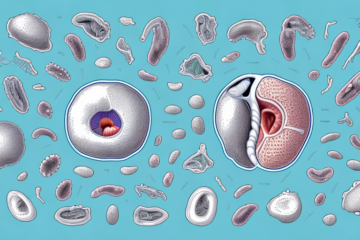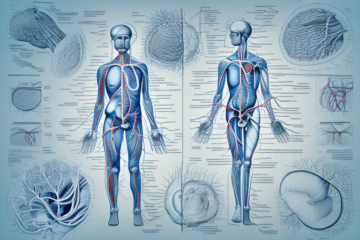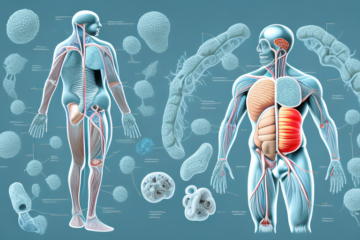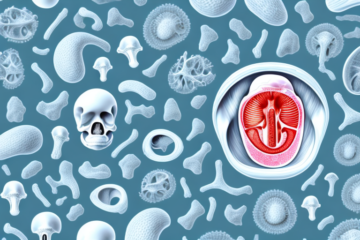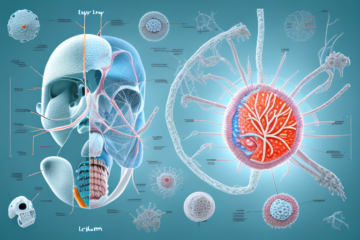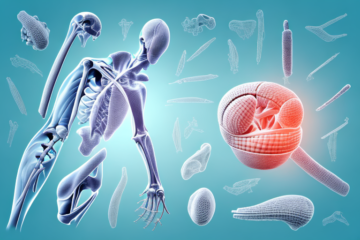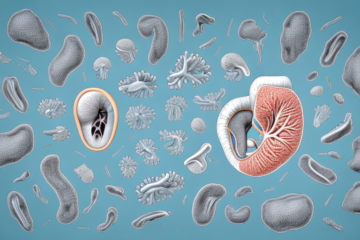The diaphragm is a thin sheet of muscle that is responsible for breathing. It is located between the chest and abdomen and plays a crucial role in respiration. In this article, we will discuss the function and anatomy of the diaphragm, as well as its importance for athletes, singers, and other groups of people. We will also explore common disorders that affect the diaphragm and provide tips for maintaining a healthy and strong diaphragm through breathing exercises.
The Role of the Diaphragm in Breathing
The diaphragm is the primary muscle responsible for breathing. When you inhale, air enters your lungs and the diaphragm contracts, moving downward to create more space for the lungs to expand. This allows air to enter the lungs and leads to inhalation. When you exhale, the diaphragm relaxes, and the air is forced out of the lungs, leading to exhalation.
It is important to note that the diaphragm also plays a crucial role in other bodily functions, such as singing, speaking, and even bowel movements. The diaphragm helps to control the flow of air and pressure in the lungs, which is necessary for producing sound when speaking or singing. Additionally, the diaphragm aids in the process of defecation by increasing intra-abdominal pressure, which helps to push stool out of the body.
Understanding the Anatomy of the Diaphragm
The diaphragm is a dome-shaped muscle that separates the thoracic cavity from the abdominal cavity. It consists of three parts: the sternal, costal, and lumbar portions. The sternal portion is connected to the sternum, the costal portion is attached to the ribs, and the lumbar portion is connected to the lumbar vertebrae. The diaphragm is innervated by the phrenic nerve, which originates from the spinal cord and travels down through the chest.
The diaphragm plays a crucial role in breathing. When it contracts, it flattens and moves downward, increasing the volume of the thoracic cavity and allowing air to enter the lungs. When it relaxes, it returns to its dome shape and moves upward, decreasing the volume of the thoracic cavity and forcing air out of the lungs. The diaphragm also helps to maintain intra-abdominal pressure, which is important for activities such as coughing, sneezing, and defecation.
Disorders of the diaphragm can lead to breathing difficulties and other symptoms. For example, a diaphragmatic hernia occurs when part of the stomach or other abdominal organs protrude through a hole in the diaphragm and into the chest cavity. This can cause chest pain, shortness of breath, and other symptoms. Treatment for a diaphragmatic hernia may involve surgery to repair the hole in the diaphragm.
How the Diaphragm Connects to Other Organs in the Body
The diaphragm connects to other organs in the body through various structures. The aorta, which is the main artery of the body, passes through the diaphragm. The esophagus, which connects the mouth and stomach, also passes through the diaphragm. Additionally, the inferior vena cava, which carries deoxygenated blood from the lower body to the heart, passes through the diaphragm.
Another important structure that connects to the diaphragm is the phrenic nerve. This nerve originates from the spinal cord and controls the movement of the diaphragm during breathing. The diaphragm also connects to the ribcage through its attachments to the lower ribs, which helps to stabilize the chest during breathing.
In some cases, the diaphragm can become weakened or damaged, leading to a condition called diaphragmatic hernia. This occurs when part of the stomach or other organs push through a hole in the diaphragm and into the chest cavity. Diaphragmatic hernia can cause difficulty breathing and requires surgical repair.
The Importance of a Strong Diaphragm for Athletes and Dancers
A strong diaphragm is important for athletes and dancers as it plays a crucial role in respiration. It allows more oxygen to flow into the body, providing energy for physical activity. Additionally, a strong diaphragm can help improve posture and reduce the risk of injury. Athletes and dancers can strengthen their diaphragm through breathing exercises, which we will discuss later in this article.
Furthermore, a strong diaphragm can also improve an athlete or dancer’s endurance. By increasing the amount of oxygen that can be taken in and utilized by the body, the diaphragm can help delay the onset of fatigue during prolonged physical activity. This can be especially beneficial for athletes and dancers who need to perform for extended periods of time, such as marathon runners or ballet dancers.
Common Diaphragmatic Disorders and Their Symptoms
Several disorders can affect the diaphragm. Some of the most common include diaphragmatic hernia, paralysis, and spasms. Symptoms of diaphragmatic hernia include chest pain, shortness of breath, and abdominal pain. Paralysis of the diaphragm can cause difficulty breathing, and spasms can lead to hiccups and chest discomfort. It is important to seek medical attention if you experience any of these symptoms.
Another common diaphragmatic disorder is diaphragmatic eventration, which occurs when the diaphragm is abnormally elevated and weakened. This can cause breathing difficulties, especially during physical activity. Treatment may involve surgery to repair or strengthen the diaphragm.
In some cases, diaphragmatic disorders can be caused by underlying medical conditions such as gastroesophageal reflux disease (GERD) or chronic obstructive pulmonary disease (COPD). Managing these conditions can help alleviate symptoms and prevent further damage to the diaphragm.
How to Strengthen Your Diaphragm with Breathing Exercises
Breathing exercises can help strengthen the diaphragm and improve lung function. One simple exercise is to lie down on your back and place a book on your stomach. Breathe deeply, and try to make the book rise and fall with each breath. Another exercise involves inhaling through your nose for four seconds, holding your breath for seven seconds, and exhaling through your mouth for eight seconds. Repeat this exercise several times a day.
In addition to these exercises, there are other ways to strengthen your diaphragm. Singing is a great way to exercise your diaphragm and improve your breathing. Joining a choir or taking singing lessons can be a fun way to incorporate diaphragm-strengthening exercises into your routine.
It’s also important to maintain good posture to support your diaphragm. Sitting up straight and avoiding slouching can help your diaphragm work more efficiently. Practicing yoga or Pilates can also help improve your posture and strengthen your core muscles, including the diaphragm.
The Connection Between the Diaphragm and Stress Management
The diaphragm is closely linked to stress management. When you are stressed, your breathing becomes shallow and rapid, which can lead to feelings of anxiety and tension. By practicing deep breathing exercises and strengthening your diaphragm, you can learn to control your breathing and reduce stress levels.
Research has shown that individuals who practice diaphragmatic breathing techniques experience a decrease in cortisol levels, which is a hormone associated with stress. This decrease in cortisol levels can lead to a reduction in symptoms of anxiety and depression.
In addition to stress management, the diaphragm also plays a crucial role in physical activities such as singing, playing wind instruments, and sports that require endurance. Strengthening your diaphragm through exercises such as yoga and Pilates can improve your overall physical performance and increase your lung capacity.
The Role of the Diaphragm in Singing and Vocal Performance
The diaphragm plays a crucial role in vocal performance as it helps control the flow of air and sound. Singers and performers can improve their vocal range and control by strengthening their diaphragm through breathing exercises. By learning to use their diaphragm effectively, they can produce a richer and more powerful sound.
In addition to its role in controlling airflow, the diaphragm also plays a key role in maintaining proper posture while singing or performing. When the diaphragm is engaged, it helps to support the spine and keep the body in an upright position. This not only improves the quality of the sound produced, but also helps prevent strain and injury to the vocal cords and surrounding muscles.
Furthermore, the diaphragm is not the only muscle involved in singing and vocal performance. Other muscles in the chest, neck, and face also play important roles in producing sound and conveying emotion. Singers and performers must learn to coordinate the movements of these muscles in order to achieve the desired effect and avoid tension or strain.
Surgical Procedures Involving the Diaphragm
Surgical procedures involving the diaphragm are relatively rare but may be necessary in some cases. Diaphragmatic hernias and paralysis may require surgery to repair or replace the damaged muscle. Surgery can also be used to remove tumors or growths that affect the diaphragm.
In addition to repairing damaged muscles and removing tumors, surgical procedures involving the diaphragm can also be used to treat certain respiratory conditions. For example, phrenic nerve stimulation involves implanting a device that sends electrical impulses to the phrenic nerve, which controls the diaphragm. This can help improve breathing in patients with conditions such as sleep apnea or chronic obstructive pulmonary disease (COPD).
Another type of surgical procedure involving the diaphragm is diaphragmatic pacing. This involves implanting electrodes in the diaphragm muscle and using a device to stimulate the muscle to contract and relax. This can be helpful for patients with spinal cord injuries or other conditions that affect the nerves that control the diaphragm.
Yoga Poses for a Healthy and Strong Diaphragm
Yoga poses can help strengthen the diaphragm and improve breathing function. Some poses that are particularly beneficial include seated forward bend, sphinx pose, and bridge pose. These poses help stretch the diaphragm and improve lung capacity.
In addition to these poses, practicing pranayama, or breathing exercises, can also help strengthen the diaphragm. Techniques such as kapalbhati, anulom vilom, and bhastrika involve controlled breathing and can improve the function of the diaphragm. It is important to practice these techniques under the guidance of a trained yoga instructor to ensure proper technique and avoid injury.
The Relationship Between Acid Reflux and the Diaphragm
Acid reflux occurs when stomach acid moves up into the esophagus, causing a burning sensation in the chest and throat. The diaphragm plays a crucial role in preventing acid reflux as it helps keep the acid in the stomach by closing off the esophagus. Damage to the diaphragm, such as a hiatus hernia, can lead to acid reflux and other digestive problems.
There are several factors that can contribute to damage of the diaphragm, including obesity, smoking, and poor posture. Obesity can put pressure on the diaphragm, causing it to weaken and become less effective at preventing acid reflux. Smoking can also weaken the diaphragm and increase the risk of acid reflux. Poor posture, such as slouching, can put pressure on the stomach and cause acid to move up into the esophagus.
There are several lifestyle changes that can help prevent acid reflux and protect the diaphragm. Maintaining a healthy weight, quitting smoking, and practicing good posture can all help reduce the risk of acid reflux and protect the diaphragm. Additionally, avoiding trigger foods, such as spicy or acidic foods, and eating smaller, more frequent meals can also help prevent acid reflux and protect the diaphragm.
The Effects of Aging on Diaphragmatic Function
As we age, our diaphragmatic function may decline, leading to decreased lung capacity and difficulty breathing. Age-related changes in the muscles and nerves that control the diaphragm can lead to reduced strength and endurance. By practicing breathing exercises and maintaining a healthy lifestyle, however, we can help preserve diaphragmatic function as we age.
In addition to the decline in diaphragmatic function, aging can also lead to changes in the structure and function of the lungs themselves. The elasticity of lung tissue decreases with age, making it more difficult to inhale and exhale fully. This can lead to a decrease in oxygen exchange and an increased risk of respiratory infections.
Furthermore, certain medical conditions, such as chronic obstructive pulmonary disease (COPD) and asthma, can exacerbate the effects of aging on diaphragmatic function. It is important for individuals with these conditions to work closely with their healthcare providers to manage their symptoms and maintain optimal lung function as they age.
Tips for Improving Your Breathing Technique through Proper Use of Your Diaphragm
To improve your breathing technique, it is important to learn how to use your diaphragm effectively. This involves taking deep breaths, inhaling slowly through your nose, and exhaling slowly through your mouth. You should also avoid shallow breathing and practice regular breathing exercises to strengthen your diaphragm.
Another important aspect of improving your breathing technique is to maintain good posture. When you sit or stand up straight, your lungs have more space to expand, allowing you to take deeper breaths. Additionally, practicing relaxation techniques such as meditation or yoga can help reduce stress and tension in your body, which can also improve your breathing.
It is also important to be aware of any potential breathing problems or conditions you may have, such as asthma or allergies. If you experience difficulty breathing or have any concerns, it is important to consult with a healthcare professional for proper diagnosis and treatment.
How to Spot Potential Issues with Your Diaphragm and When to Seek Medical Attention
If you experience any symptoms related to your breathing, such as shortness of breath, chest pain, or difficulty inhaling or exhaling, you should seek medical attention. These symptoms may be related to disorders that affect the diaphragm, such as hernias, paralysis, or spasms. By seeking prompt medical attention, you can prevent further complications and ensure that you receive the appropriate treatment.
In conclusion, the diaphragm is a crucial muscle that plays a vital role in breathing. By understanding its function and anatomy, we can learn how to maintain a healthy and strong diaphragm through breathing exercises and other techniques. Whether you are an athlete, singer, or simply looking to improve your overall health and well-being, a strong diaphragm can help you achieve your goals.
It is important to note that certain lifestyle factors can also affect the health of your diaphragm. Smoking, for example, can weaken the diaphragm and make it more difficult to breathe properly. Additionally, poor posture can put unnecessary strain on the diaphragm and lead to breathing difficulties over time. By making healthy lifestyle choices and practicing good posture, you can help maintain the health of your diaphragm and prevent potential issues from arising.


